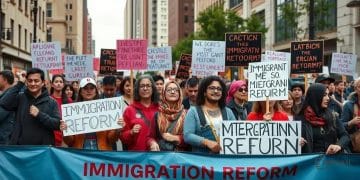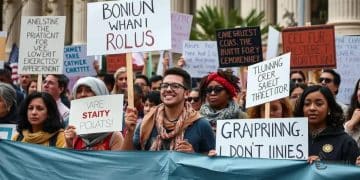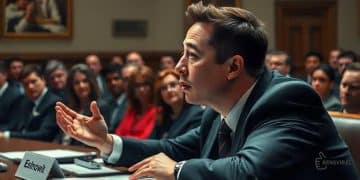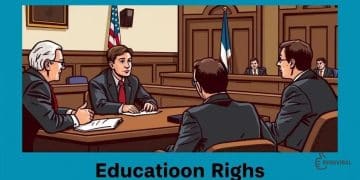Lawsuits challenging actions taken by the Trump administration
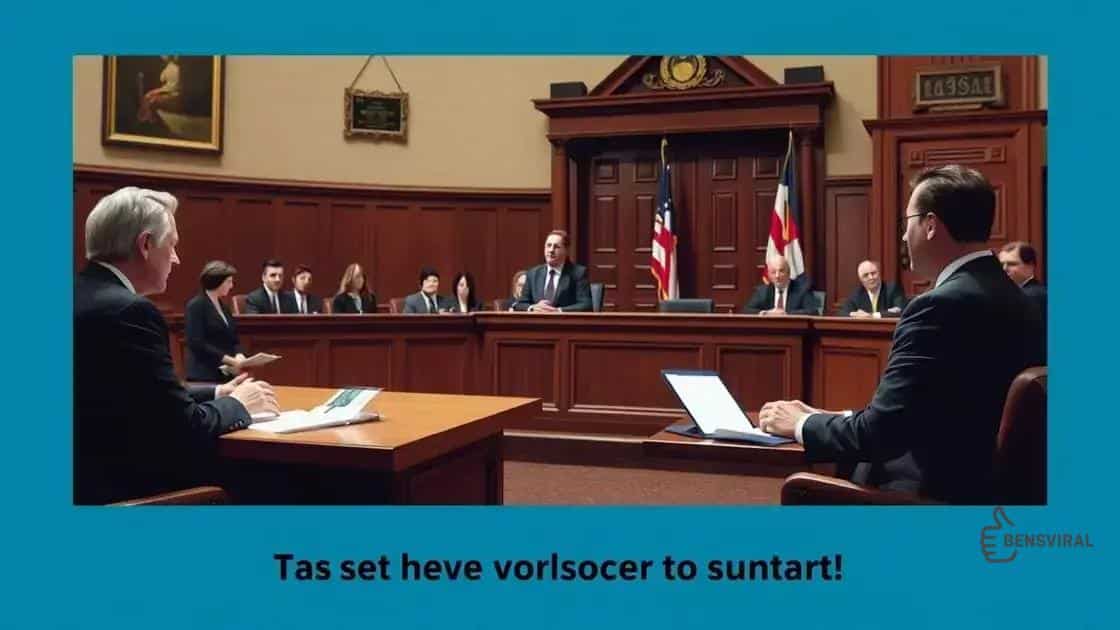
Lawsuits challenging actions taken by the Trump administration focused on key issues like the travel ban, DACA, and immigration policies, shaping public debate and influencing legal precedents in the U.S.
Lawsuits challenging actions taken by the Trump administration have shaped a unique landscape in U.S. politics. These legal battles raise questions about governance and accountability, igniting debates that resonate into the present. Let’s dive into the details of these significant lawsuits.
Overview of the Trump administration’s key actions
The Trump administration has been a focal point of American politics, with numerous policies that have sparked national debates and legal challenges. This overview highlights some of the key actions that defined his time in office.
Key Policy Initiatives
During his presidency, Trump enacted several significant policies, affecting various sectors. One such initiative was the tax reform, which aimed to boost the economy by reducing taxes for individuals and corporations. Another notable action was the immigration policy changes, which included attempts to build a border wall and implement travel bans from certain countries.
- Tax reform aimed at reducing individual and corporate taxes.
- Immigration policies focusing on border security and restrictions.
- Healthcare efforts to repeal and replace the Affordable Care Act.
- Environmental regulations targeting energy production and climate change.
These actions not only captured headlines but also led to a myriad of lawsuits questioning their legality. For instance, many states challenged the immigration orders, claiming they violated constitutional rights.
Controversial Executive Orders
Trump’s use of executive orders was another hallmark of his administration. He signed orders that addressed various issues rapidly. For example, an executive order aimed at withdrawing the U.S. from the Paris Agreement raised eyebrows and led to widespread criticism. Many believed this would negatively impact global efforts to combat climate change.
Furthermore, his administration’s efforts to roll back regulations on environmental protections fueled controversy. Critics argued that these moves prioritized short-term economic gains over long-term sustainability.
As a result, various environmental groups filed lawsuits against the administration, citing the need to protect natural resources and public health. An interesting dynamic arose, as the administration’s actions were often met with legal challenges that highlighted the tension between policy making and the judicial system.
Conclusion
In summary, the Trump administration’s key actions were pivotal in shaping a controversial legacy. His policies and executive decisions sparked significant public and legal reactions, reflecting a continuing debate on governance in America.
Major lawsuits filed against the Trump administration
Numerous major lawsuits were filed against the Trump administration during its time in office. These legal actions often challenged policies and executive orders that many believed were unconstitutional or harmful.
High-Profile Cases
One of the most significant lawsuits targeted the administration’s travel ban, which restricted entry from several predominantly Muslim countries. This ban led to widespread protests and legal challenges, as critics argued it violated the rights of individuals and was based on discriminatory practices.
- Travel ban and its legal challenges from states.
- Environmental lawsuits against deregulation measures.
- Litigation regarding the administration’s handling of DACA.
- Challenges to family separation policies at the border.
Another high-profile case involved the Deferred Action for Childhood Arrivals (DACA), where plaintiffs argued that ending the program would unlawfully disrupt the lives of thousands of immigrants. This led to a Supreme Court ruling that temporarily blocked the administration’s attempts to end DACA.
Consequences of the Legal Battles
Each lawsuit had varying degrees of impact, not only on the Trump administration but also on public opinion. As lawsuits progressed, they not only highlighted concerns about specific policies but also showcased the ongoing struggle between state and federal powers. Many of these legal battles illustrated the complex relationship between government actions and individual rights.
For example, the lawsuits concerning environmental regulations were not merely about policy changes; they signified a broader debate over climate change and public health. Environmental groups asserted that easing restrictions could have long-term detrimental effects. The resulting court cases became a platform for advocates to voice their concerns and push for more sustainable practices.
Public and Political Impact
These lawsuits also energized political movements, as citizens rallied around the legal efforts to challenge the Trump administration’s actions. Activist groups mobilized around pivotal cases, driving public discourse and participation in the political process. Social media played a crucial role in spreading information, drawing attention to injustices, and encouraging grassroots organizing.
Key outcomes of the lawsuits
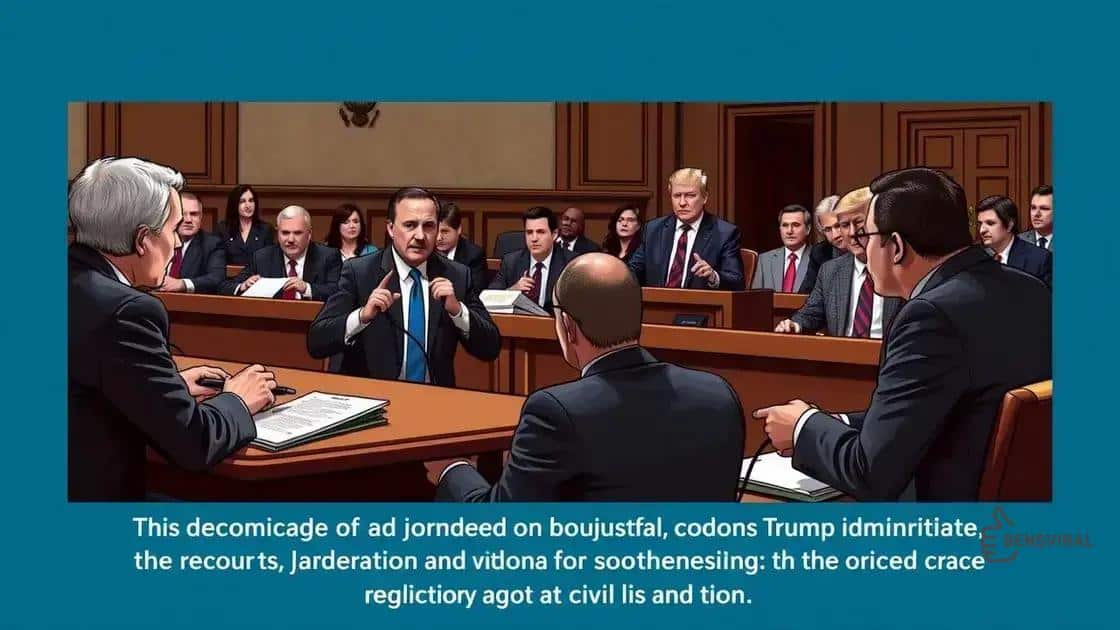
The lawsuits against the Trump administration led to several important outcomes that shaped public policy and legal precedents. Many of these cases addressed crucial issues affecting a wide range of Americans.
Significant Rulings
One of the key outcomes was the Supreme Court’s decision on the travel ban. In 2018, the Court upheld a revised version, stating it was within the President’s authority. This ruling set a precedent for future executive actions, raising concerns about the balance of power.
- Supreme Court ruling on the travel ban upheld presidential authority.
- DACA remains in place, affirming protections for Dreamers.
- Environmental regulations were challenged, leading to more stringent reviews.
- State rights were reinforced through various lawsuits.
Another vital outcome involved the protection of the Deferred Action for Childhood Arrivals (DACA) program. The Supreme Court ruled against the administration’s efforts to end it, ensuring that thousands of Dreamers were allowed to continue living and working legally in the U.S. This decision underscored the importance of legislative protections.
Policy Reversals and Changes
As a result of ongoing lawsuits, some policies experienced reversals or modifications. The administration faced pressure to reassess actions related to environmental policy. Many lawsuits focused on regulatory rollbacks that could harm clean air and water. Consequently, new reviews were initiated to ensure compliance with existing laws.
Furthermore, the backlash against certain immigration policies prompted the administration to adjust its strategies. Increased legal challenges also spotlighted the necessity for clear, fair immigration practices. Both public sentiment and legal outcomes contributed to shifting approaches within the administration.
Public Awareness and Activism
The high-profile nature of these lawsuits sparked widespread public awareness and activism. Citizens became more engaged in political processes and mobilized around issues such as justice and equality. Many advocacy groups expanded their efforts, rallying support and resources to address the implications of the administration’s policies.
Impact of these lawsuits on policy implementation
The impact of these lawsuits on policy implementation during the Trump administration was profound. These legal challenges not only stalled certain policies but also prompted a reevaluation of existing strategies.
Stalled Policies and Delays
Many policies faced delays due to ongoing litigation. For instance, attempts to implement the travel ban were met with immediate legal challenges that halted enforcement. This led to uncertainty among travelers and immigration officials alike.
- Delays in immigration policy rollout influenced public perception.
- Legal obstacles affected environmental regulations significantly.
- Executive orders faced court injunctions, impacting administration goals.
- Policy changes were often postponed due to judicial reviews.
Additionally, the backlash against environmental deregulations often meant that agencies had to follow stricter guidelines while navigating lawsuits. Legal challenges kept the administration on its toes, ensuring that any new policies were scrutinized closely.
Reevaluation of Policies
As lawsuits mounted, the Trump administration sometimes reconsidered its approaches. For example, new strategies were developed in response to court decisions regarding health care and immigration. The need to adapt often arose from the realization that some policies were not only controversial but also legally vulnerable.
In many instances, lawsuits forced more transparency and accountability in policy creation. Advocates argued that this scrutiny made for better governance, as legal teams sought to ensure compliance with laws and regulations. This shift allowed for more comprehensive discussions about the implications of certain policies, particularly those affecting marginalized communities.
Increased Advocacy and Engagement
These legal battles also inspired increased advocacy and public engagement. Citizens became more aware of how laws impacted their lives, leading to heightened activism. Various groups organized protests and campaigns to influence policy discussions, drawing attention to the stakes involved in the legal outcomes.
Public reaction and media coverage
The public reaction and media coverage surrounding the lawsuits against the Trump administration played a crucial role in shaping the national conversation. As various legal battles unfolded, the media reported extensively on the developments, informing the public about the implications of each case.
Media Coverage of Key Events
Major news outlets provided real-time updates on key lawsuits, ensuring that citizens were aware of court rulings and actions taken by the administration. Coverage included details about the travel ban, DACA challenges, and other high-stakes legal issues.
- In-depth analyses of Supreme Court decisions.
- Investigative reports highlighting significant legal implications.
- Feature stories on affected individuals and communities.
- Public forums and discussions influenced by media coverage.
Media narratives often shaped how the public perceived these lawsuits. For instance, human interest stories highlighted the struggles of immigrants affected by the travel ban. This brought greater awareness to the emotional and social impacts of legal decisions.
Public Mobilization and Activism
The coverage of these lawsuits inspired many to mobilize. Social media became a powerful tool for advocacy, as individuals shared information about ongoing cases and organized protests or campaigns. Many citizens felt compelled to participate in civic activities, pushing back against policies they deemed harmful.
Reports in the media often served as a catalyst for public opinion shifts. By shedding light on legal proceedings, the media helped galvanize movements that supported justice and equity. Activist groups used coverage to amplify their messages and draw attention to pressing issues, ensuring that the public remained engaged.
Impact on Political Discourse
As media outlets covered the lawsuits, discussions about government accountability and constitutional rights flourished. Public forums and debates sprang up, creating spaces for citizens to express their views. The visibility of these cases in the media led to broader conversations about democracy and governance in America.
FAQ – Frequently Asked Questions about Lawsuits Challenging the Trump Administration
What are the major lawsuits against the Trump administration?
Key lawsuits include challenges to the travel ban, DACA protections, and various immigration policies.
How did the public react to these lawsuits?
Public reaction included increased activism and awareness, with many citizens becoming more engaged in civic activities.
What role did the media play in covering these lawsuits?
The media provided extensive coverage, informing the public about the implications of the lawsuits and highlighting human interest stories.
What impact did these lawsuits have on policy?
These lawsuits influenced policy implementation, causing delays and prompting the administration to reevaluate certain strategies.

